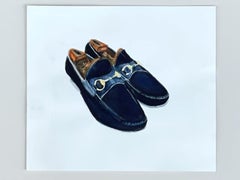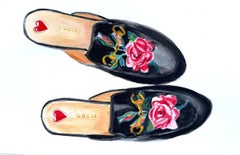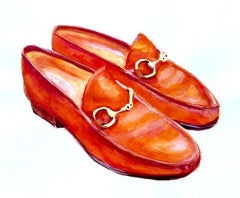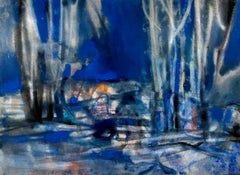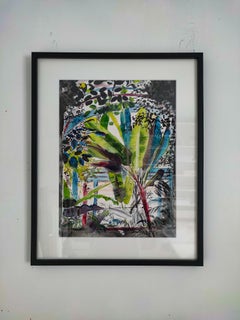Christina Ruggieri Paintings
American, b. 1971
Christina Ruggieri grew up between Manhattan and Eastern Long island. Aside from a few watercolor workshops at the 92nd St Y, she is largely self-taught, and favors watercolor and acrylic gouache. The Gucci Loafers series is an homage to her late father, who collected them, and wore them every day to work and on weekends.(Biography provided by karyn mannix contemporary)
to
3
2
1
3
Overall Height
to
Overall Width
to
3
3
3
913
666
655
610
3
3
Artist: Christina Ruggieri
Gucci Loafer Blue Suede
By Christina Ruggieri
Located in East Hampton, NY
Vintage Blue Suede Gucci Loafers Watercolor Painting
Not Framed
Watercolor on 140 lb. Arches Aquarelle hot press watercolor paper.
About the ...
Category
2010s Modern Christina Ruggieri Paintings
Materials
Watercolor
Gucci -Rose Slide
By Christina Ruggieri
Located in East Hampton, NY
Vintage Gucci Rose Slides Watercolor Painting
Not Framed
Watercolor on 140 lb. Arches Aquarelle hot press watercolor paper.
About the Artist
Christina Rugg...
Category
2010s Modern Christina Ruggieri Paintings
Materials
Watercolor
Gucci Loafer -Brown
By Christina Ruggieri
Located in East Hampton, NY
Vintage Gucci Loafers Watercolor Painting
Not Framed
Watercolor on 140 lb. Arches Aquarelle hot press watercolor paper.
About the Artist
Christina Rugg...
Category
2010s Modern Christina Ruggieri Paintings
Materials
Watercolor
Related Items
Large Modernist Abstract Expressionist Gouache Painting Bauhaus Weimar Artist
By Pawel Kontny
Located in Surfside, FL
Abstract watercolor or gouache composition bearing the influence of the earlier color-block compositions of Paul Klee.
Pawel August Kontny, (Polish-German-American artist) He was born in Laurahuette, Poland, in 1923, the son of a wealthy pastry shop owner. In 1939 he began studying architecture in Breslau where he was introduced to the European masters and to the work of some of the German Expressionists, soon afterward banned as "degenerate artists" and removed from museums throughout Germany by the Nazi regime. His studies were interrupted by World War II. Drafted into the German army, traveling in many countries as a soldier, he sketched various landscapes but in 1945, he was captured and held as a prisoner of war in Italy. After the war, he studied at the Union of Nuremberg Architects to help design buildings to replace ones destroyed in the war. He recorded his impressions of the local population and the landscapes through his watercolors and drawings. Pawel Kontny thereafter moved to Nuremberg, Germany, becoming a member of the Union of Nuremberg Architects and helping to rebuild the city's historic center. He soon decided to concentrate on his professional art career. He married Irmgard Laurer, a dancer with the Nuremberg Opera. Pavel Kontny 's career as an artist was launched with his participation in an all German exhibition, held at the Dusseldorf Museum in 1952. He held one-man shows in Germany, Switzerland and the United States. During his trip to the United States in 1960, Kontny became instantly enamored with Colorado, and decided to relocate to Cherry Hills with his wife and two children. He quickly established himself in the local art community, being affiliated for a time with Denver Art Galleries and Saks Galleries. His subject matter became the Southwest. During this time he received the Prestigious Gold Medal of the Art Academy of Rome. His extensive travel provided material for the paintings he did using his hallmark marble dust technique. he also worked equally in pastel, watercolor, charcoal and pencil-and-ink. in a style which merged abstraction and realist styles, influenced by Abstract Expressionist painting and South Western American landscapes. In the early 1960s he was one of only a few European-born professional artists in the state, a select group that included Herbert Bayer (1900-1985), a member of the prewar Bauhaus in Weimar and Dessau, Germany, and Roland Detre (1903-2001), a Hungarian modernist painter. As a Denver, Colorado resident, Pavel Kontny exhibited at galleries and museums throughout the United States, Germany and Japan. There, he was inspired by frequent trips to Native American pueblos in the Southwest, as well as by the study of the Plains Indians of Montana and Wyoming. Over the years Kontny had a number of students and generously helped young artist by hosting exhibitions at his Cherry Hills home. For many years he generously donated his paintings to support charitable causes in Denver. Influences during his European years included German pastelist C.O. Muller, German Informel painter Karl Dahmen and Swiss artist, Hans Erni. In the early 1950s his painting style showed the influence of the Die Brücke (The Bridge), a group of German expressionist artists formed in Dresden in 1905 who had a major impact on the evolution of modern art in the twentieth century in Germany. By the middle of the decade his style incorporated more referential abstraction and total abstraction, resulting in part from his study of Hans Hartung, a German artist based in Paris who exhibited his gestural abstract work in Germany. The American moon landing in 1969 inspired Paul Kontny...
Category
20th Century American Modern Christina Ruggieri Paintings
Materials
Watercolor, Archival Paper
"Green Secret", watercolor and ink on paper
Located in THOMERY, FR
This work is part of the artist's Les Naturenales series which celebrates the contemplation of nature through sensual artworks on paper.
The background of the work, realized on water...
Category
21st Century and Contemporary Modern Christina Ruggieri Paintings
Materials
Watercolor, Ink
The Dancers, French Late Mid Century Gouache on Textured Paper
Located in Cotignac, FR
Late Mid Century French watercolour and Gouache on handmade paper of a pair of dancers by Damien Hermellin. Signed and dated bottom right. Pres...
Category
1970s Modern Christina Ruggieri Paintings
Materials
Watercolor, Paper, Gouache, Handmade Paper
H 18 in W 15.5 in D 1.5 in
Very Early 1950s Abstract Texas Desert Landscape
By Paul Maxwell
Located in Houston, TX
Early Abstract Paul Maxwell Landscape of the Texas desert done in blue tones. Watercolor on paper from the 1950s.
Dimensions Without Frame: H 15 in. x W ...
Category
1950s Modern Christina Ruggieri Paintings
Materials
Watercolor
Americana, Lawyer in Court, Politician, Gouache Painting WPA Art William Gropper
By William Gropper
Located in Surfside, FL
William Gropper Original Gouache on Paper
Hand signed lower right
33.5 x 27.5 image 26 x 20.5
The New-York born artist William Gropper was a painter and cartoonist who, with caricature style, focused on social concerns, and was actively engaged in support of the organized labor movement throughout his career. This original watercolor drawing is done in the iconic style of the artist's oeuvre.
Born to Harry and Jenny Gropper in 1897, William was raised in New York City's Lower East Side. His parents were Jewish immigrants from Romania and Ukraine, and young William grew up in relative poverty, watching his family struggle to achieve that sought-after American dream. His father, a bright and college-educated man, was unable to find employment that worthy of his intellect. His mother, meanwhile, worked as a seamstress from home. Coupled with the devastating loss of an aunt to the infamous Triangle Factory fire of 1911, significant childhood factors created the foundation that led to Gropper’s exploration of the American experience.
Early on, Gropper displayed an extraordinary, natural skill for art. By 1912, he was already studying under the instruction of George Bellows and Robert Henri at the Ferrer School in Greenwich Village. During his time at school, Gropper was also awarded a prestigious scholarship to study at the National Academy of Design. However, he refused to fit into convention and was swiftly expelled from the Academy. After his expulsion, Gropper returned home to help financially by assisting his mother and taking a shop position. However, he didn't abandon art academia and soon presented a portfolio to the New York School of Fine Art which earned him a scholarship for study.
Gropper obtained his first significant job as a cartoonist for the New York Tribune in 1917. While working as a staff cartoonist for the Tribune, he also contributed drawings to publications like Vanity Fair, New Masses, The Nation, and Freiheit. His interest in the welfare of the American worker, class inequality, and social injustice was central in his work. After publishing the graphic novel Alley Oop in 1930, Gropper's illustration career extended well into the decade. However, he was never exempt from controversy, and his 1935 Vanity Fair cartoon; prompted anger from the Japanese government.
As an involved labor organizer and Social Realist activist, Gropper continued to bring attention to his radical reputation with visits to the Soviet Union and Poland. However, his concern with European politics and U.S. social causes didn't slow down his artistic career, and by the late 1930s, he had produced significant murals for American cities like Washington D.C. His 1938 mural Construction of a Dam was commissioned for the Department of the Interior and represents the Social-Realism style that depicts experiences of the worker and everyday societal life. Measuring at a staggering 27ft by 87ft, the piece portrays muscular, robust American laborers scaling rocky hillsides, building infrastructure, and operating heavy machinery. The mural feels undeniably American with golden scenery, denim blues, and steely gray colors. Gropper fits perfectly into Social-Realism because the style exhibits an illustrative flair with strong lines and simple, bold hues.
The inspiration for Construction of a Dam sprang from his 1937 travels to the poverty-stricken Dust Bowl area. The trip was sponsored by a Guggenheim Foundation Fellowship, and his drawings of the Grand Coulee and Boulder Dams...
Category
Mid-20th Century Modern Christina Ruggieri Paintings
Materials
Ink, Watercolor, Gouache
Israeli Modernist Watercolor Painting Safed Synagogue Interior Bezalel School
By Mordechai Avniel
Located in Surfside, FL
Watercolor painting of Shul interior in Tzfas, Safed Israel.
MORDECHAI AVNIEL
Minsk, Belarus, b. 1900, d. 1989
Mordecai Dickstein (later Avniel) was born in 1900 in Minsk, present-day Belarus. He studied fine arts in Yekaterinburg, Russia (1913–19) and at the Bezalel Academy of Art and Design, Jerusalem (1923). Avniel immigrated to Palestine in 1921 where he first worked as a pioneer in citrus plantations near Petah Tikva. In 1923, at the urging of Boris Schatz, he went to Jerusalem to further his art studies at Bezalel. He later taught painting and sculpture at the school, and served a term as director of the Small Sculpture Section of the Sculpture Department (1924–28). From 1935 on, Avniel lived in Haifa. Avniel was also a lawyer and a founding partner of the Haifa firm Avniel, Salomon & Company.
Avniel regularly showed his work in group exhibitions of the Painters and Sculptors' Association of Israel. He was awarded the Herman Struck Prize (1952), Tenth Anniversary Prize for Watercolours, Ramat Gan (1958), Histadrut Prize (1961), and First Prize Haifa Municipality (1977). He represented Israel at the 1958 Venice Biennale and the 1962 International Art Seminar at Fairleigh Dickinson University. Avniel was a member of the Artists' Colony in Safed and maintained a studio on Mount Carmel.
Mordechai Avniel is best known for his deft and singular landscape work.
His works are held in numerous museums and collections both in Israel and abroad, including the Metropolitan Museum, New York and the Carnegie Institute, Pittsburgh, PA. Avniel's manipulations of light and colour share much with those of compatriot artists Shimshon Holzman and Joseph Kossonogi.
Education
1913-19 Art School of Katrinburg, Russia
1923 Bezalel School of Art, Jerusalem
Selected exhibitions:
2004: Our Landscape: Notes on Landscape Painting in Israel, University of Haifa Art Gallery, Haifa (online catalogue)
1965: Mordechai Avniel Retrospective, Haifa Municipality Museum of Modern Art, Haifa
1964: Galerie Synthèse, Paris
1962: New York University, New York
1961: Rina Gallery of Modern Art, Jerusalem
The Autumn Exhibition Rina Gallery, Jerusalem
Artists: Dedi Ben Shaul...
Category
20th Century Modern Christina Ruggieri Paintings
Materials
Paper, Watercolor
Rare Modernist Hungarian Rabbi Pastel Drawing Gouache Painting Judaica Art Deco
By Hugó Scheiber
Located in Surfside, FL
Rabbi in the synagogue at prayer wearing tallit and tefillin.
Hugó Scheiber (born 29 September 1873 in Budapest – died there 7 March 1950) was a Hungarian modernist painter.
Hugo Scheiber was brought from Budapest to Vienna at the age of eight where his father worked as a sign painter for the Prater Theater. At fifteen, he returned with his family to Budapest and began working during the day to help support them and attending painting classes at the School of Design in the evening, where Henrik Papp was one of his teachers. He completed his studies in 1900. His work was at first in a post-Impressionistic style but from 1910 onward showed his increasing interest in German Expressionism and Futurism. This made it of little interest to the conservative Hungarian art establishment.
However, in 1915 he met the great Italian avant-gardist Filippo Tommaso Marinetti and the two painters became close friends. Marinetti invited him to join the Futurist Movement. The uniquely modernist style that he developed was, however, closer to German Expressionism than to Futurism and eventually drifted toward an international art deco manner similar to Erté's. In 1919, he and his friend Béla Kádar held an exhibition at the Hevesy Salon in Vienna. It was a great success and at last caused the Budapest Art Museum to acquire some of Scheiber's drawings. Encouraged, Scheiber came back to live in Vienna in 1920.
A turning point in Scheiber's career came a year later, when Herwarth Walden, founder of Germany's leading avant-garde periodical, Der Sturm, and of the Sturm Gallery in Berlin, became interested in Scheiber's work. Scheiber moved to Berlin in 1922, and his paintings soon appeared regularly in Walden's magazine and elsewhere. Exhibitions of his work followed in London, Rome, La Paz, and New York.
Scheiber's move to Germany coincided with a significant exodus of Hungarian artists to Berlin, including Laszlo Moholy-Nagy and Sandor Bortnyik. There had been a major split in ideology among the Hungarian avant-garde. The Constructivist and leader of the Hungarian avantgarde, Lajos Kassák (painted by Hugó Scheiber in 1930) believed that art should relate to all the needs of contemporary humankind. Thus he refused to compromise the purity of his style to reflect the demands of either the ruling class or socialists and communists. The other camp believed that an artist should be a figurehead for social and political change.
The fall out and factions that resulted from this politicisation resulted in most of the Hungarian avant gardists leaving Vienna for Berlin. Hungarian émigrés made up one of the largest minority groups in the German capital and the influx of their painters had a significant effect on Hungarian and international art. Another turning point of Scheiber's career came in 1926, with the New York exhibition of the Société Anonyme, organized by Katherine Dreier. Scheiber and other important avant garde artists from more than twenty-three countries were represented. In 1933, Scheiber was invited by Marinetti to participate in the great meeting of the Futurists held in Rome in late April 1933, Mostra Nazionale d’Arte Futurista where he was received with great enthusiasm. Gradually, the Hungarian artists began to return home, particularly with the rise of Nazism in Germany. Kádar went back from Berlin in about 1932 and Scheiber followed in 1934.
He was then at the peak of his powers and had a special flair in depicting café and cabaret life in vivid colors, sturdily abstracted forms and spontaneous brush strokes. Scheiber depicted cosmopolitan modern life using stylized shapes and expressive colors. His preferred subjects were cabaret and street scenes, jazz musicians, flappers, and a series of self-portraits (usually with a cigar). his principal media being gouache and oil. He was a member of the prestigious New Society of Artists (KUT—Képzőművészek Új Társasága)and seems to have weathered Hungary's post–World War II transition to state-communism without difficulty. He continued to be well regarded, eventually even receiving the posthumous honor of having one of his images used for a Russian Soviet postage stamp (see image above). Hugó Scheiber died in Budapest in 1950.
Paintings by Hugó Scheiber form part of permanent museum collections in Budapest (Hungarian National Museum), Pecs (Jannus Pannonius Museum), Vienna, New York, Bern and elsewhere. His work has also been shown in many important exhibitions, including:
"The Nell Walden Collection," Kunsthaus Zürich (1945)
"Collection of the Société Anonyme," Yale University Art Gallery, New Haven, Connecticut (1950)
"Hugó Scheiber: A Commemorative Exhibition," Hungarian National Museum, Budapest (1964)
"Ungarische Avantgarde," Galleria del Levante, Munich (1971)
"Paris-Berlin 1900-1930," Centre Georges Pompidou, Paris (1978)
"L’Art en Hongrie, 1905-1920," Musée d’Art et l’Industrie, Saint-Etienne (1980)
"Ungarische Avantgarde in der Weimarer Republik," Marburg (1986)
"Modernizmus," Eresz & Maklary Gallery, Budapest (2006)
"Hugó Scheiber & Béla Kádár," Galerie le Minotaure, Paris and Tel Aviv (2007)
Hugó Scheiber's paintings continue to be regularly sold at Sotheby's, Christie's, Gillen's Arts (London), Papillon Gallery (Los Angeles) and other auction houses.
He was included in the exhibition The Art Of Modern Hungary 1931 and other exhibitions along with Vilmos Novak Aba, Count Julius Batthyany, Pal Bor, Bela Buky, Denes Csanky, Istvan Csok, Bela Czobel, Peter Di Gabor, Bela Ivanyi Grunwald, Baron Ferenc Hatvany, Lipot Herman, Odon Marffy, C. Pal Molnar...
Category
Early 20th Century Modern Christina Ruggieri Paintings
Materials
Paper, Charcoal, Pastel, Watercolor, Gouache
Chicago Jewish Modernist Judaica Painting Simchat Torah WPA Artist Israeli Flags
By Alexander Raymond Katz
Located in Surfside, FL
This has young ISraeli pioneers dancing with the flag as typical of works of the late British mandate Palestine era early state of Israel.
Genre: Modern
Subject: Figurative (stained glass style)
Medium: Mixed media gouache on paper
Hand signed lower left
Alexander Raymond Katz, Hungarian / American (1895 – 1974)
Alexander Raymond Katz was born in Kassa, Hungary, and came to the United States in 1909. He studied at the Art Institute of Chicago and the Chicago Academy of Fine Arts. In the late 1920s, he worked as a director of the Poster Department at Paramount Studios. He was appointed the Director of Posters for the Chicago Civic Opera in 1930.
During the Great Depression, notable architect Frank Lloyd Wright urged Katz to become a muralist. In 1933, he was commissioned to paint a mural for the Century of Progress exposition in Chicago. In 1936, he painted the mural History of the Immigrant for the Madison, Ill., post office. Katz’s works were included in various exhibitions and now are part of several museum collections, including those of the Art Institute of Chicago; Corcoran Gallery of Art, Washington, D.C.; and the Jewish Museum, New York. His murals, bas-reliefs and stained glass designs adorn more than 200 Jewish synagogues in the United States.
Katz and other Jewish artists in Chicago who expressed Jewish and Biblical themes were inspired by the artist Abel Pann (1883-1963). Pann, who is regarded as the leading painter of the Land of Israel, exhibited in the Art Institute of Chicago in 1920.
Early in his career, Katz began to explore the artistic possibilities inherent in the characters of the Hebrew alphabet. He developed aesthetic and philosophical interpretations of each letter and became the leading innovator and pioneer in the field of Hebraic art.
Katz applies this concept in the woodcut Moses and the Burning Bush. Hebrew letters appears in Moses’ head, his cane and inside the flame. The initial of Moses’ name crowns his head. The letter in the flame is the first letter of the name of God. A combination of images and Hebrew letters appeared commonly in illustrations of the scene Moses and the Burning Bush in the Haggadah, the book of Passover.
The symbolism of the burning bush corresponds to the motifs of A Gift to Biro-Bidjan. Among the fourteen participating artists were notable Chicago modernists Todros Geller, Mitchell Siporin...
Category
Mid-20th Century Modern Christina Ruggieri Paintings
Materials
Paper, Gouache
Classical French Figures in City -1950's French Modernist Cubist Painting signed
By Bernard Labbe
Located in Cirencester, Gloucestershire
Classical Figures
by Bernard Labbe (French mid 20th century)
signed original watercolour/ gouache painting on paper board, unframed
size: 13 x 9.25 inches
condition: very good and re...
Category
Mid-20th Century Modern Christina Ruggieri Paintings
Materials
Watercolor, Ink, Gouache
The Bawdy Wind that Kisses All it Meets, Modern Art, Warm Landscape Painting
By Rosie Phipps
Located in Deddington, GB
The Bawdy Wind that Kisses all it meets is an original watercolour and gouache painting by artist Rosie Phipps, sold mounted. Featuring her gestural and expressive use of mark making...
Category
21st Century and Contemporary Modern Christina Ruggieri Paintings
Materials
Paper, Watercolor, Gouache
H 7.88 in W 14.18 in D 0.04 in
Original Painting. Fortune Mag Cover Published 1938. American Scene Modern WPA
By Antonio Petruccelli
Located in New York, NY
Original Painting. Fortune Mag Cover Published 1938. American Scene Modern WPA
Antonio Petruccelli (1907 - 1994)
Fortune cover published, January ...
Category
1930s American Modern Christina Ruggieri Paintings
Materials
Board, Gouache
1940's American WPA Modernist New York City Watercolor Painting Tenement Market
By Samuel Grunvald
Located in Surfside, FL
The Market, (fauvist painting of NYC scene) 1940's.
image is 10X 11.5 inches. Hand signed lower right
Lower East Side Tenements Pushcart Market
Samuel Grunvald was a Hungarian born American WPA artist known for abstract, landscape and seascape paintings.
Arrived in the USA from Hungary in 1921 and settled in New York City where he studied at the Art Students League. Grunvald worked for the Federal Art Project, taught at Colony House in NYC. Member: Art Guild, Watercolor Society, New York Watercolor Club. exhibited at Montross Gallery, NYC, World House Galleries, NYC, Leonard Hutton Gallery, NYC, Associated American Artists Gallery and the A.C.A. Gallery. Gunvald's work spanned many modern American movements from the WPA to Abstract Expressionist painting. He was a member of the American Watercolor Society and the Brooklyn Society of Artists. He exhibited with both of these organizations and at the Brooklyn Museum of Art. He was involved the the WPA being a Federal Arts Project artist. A number of prominent Jewish artists participated in this New Deal program among them Ben Shahn, Joseph Solman, William Gropper, Philip Guston Adolph Gottlieb, Mark Rothko, Milton Avery, Ben Shahn, the Soyers (Isaac, Moses, and Raphael), and many others
Grunwald exhibited alongside other popular artists such as Paul Klee, Jean Arp, Max Ernst and Charles Burchfield. He also taught and lectured on art and easel painting, Federal Art Project, NYC. His work is included in the collections of the Museum of Modern Art and The Jewish Museum, New York. Americana.
Select Exhibitions
A.C.A. Gallery
Associated American Artists Gallery, 1936-1955
American Watercolor Society, 1932-1942
New York Watercolor Club, 1935-1937
Humanist Art...
Category
1940s Modern Christina Ruggieri Paintings
Materials
Watercolor
Christina Ruggieri paintings for sale on 1stDibs.
Find a wide variety of authentic Christina Ruggieri paintings available for sale on 1stDibs.
